
Rad Women Worldwide tells fresh, engaging, and inspiring tales of perseverance and radical success by pairing well researched and riveting biographies with powerful and expressive cut-paper portraits. Covering the time from 430 B.C.E. to 2016, spanning 31 countries around the world, the book features an array of diverse figures, including Hatshepsut (the great female king who ruled Egypt peacefully for two decades), Malala Yousafzi (the youngest person to win the Nobel Peace Prize), Poly Styrene (legendary teenage punk and lead singer of X-Ray Spex), and Liv Arnesen and Ann Bancroft (polar explorers and the first women to cross Antarctica). This progressive and visually arresting book is a compelling addition to works on women's history.

Author Kate Schatz and artist Miriam Klein Stahl have created a book that Margaret Cho says "needs to be in every school, library, and home."
Enjoy these excerpts and check out the book at Penguin Random House.

Malala Yousafzai
July 12, 1997 (Mingora, Pakistan)
"When the whole world is silent, even one voice becomes powerful."
Malala Yousafzai was in chemistry class when a teacher came into the room with exciting news. "Malala! You've won the Nobel Peace Prize!" At 17, Malala was the youngest person -- and the first Pakistani -- to win the prestigious award. Her classmates cheered, and Malala hugged her teacher. Then she went back to her studies and finished the school day.
Just three years earlier, Malala had lain in a hospital bed in Pakistan, fighting for her life. The 14-year-old had been shot in the head, and no one expected her to survive. If she did make it, her doctors said, she almost certainly wouldn't be able to walk, read, or speak.
The men who shot Malala were part of a terrorist group called the Taliban, who believe women and girls should not have rights. They controlled her town in northwest Pakistan, near the Afghanistan border. They banned television, destroyed schools, and attacked girls who tried to learn.
When Malala was 11, a British news organization called the BBC had wanted to find a local schoolgirl to write about what it was like to live under extremist rule. They reached out to Malala's father, a teacher, and asked if his daughter would like to do it. He knew it would be dangerous, but Malala overheard his conversation and insisted that she do it. "Why not me?" she asked. She wanted to speak up for herself, and for the girls in her community.
Malala's diary was published on the BBC's website for 10 weeks, and people all over the world read her story. The first entry described a bad dream she'd had: "I had a terrible dream yesterday with military helicopters and the Taliban. I have had such dreams since the launch of the military operation in Swat. My mother made me breakfast and I went off to school. I was afraid . . ."
This brought Malala respect and admiration, but it also made her a target. Even though the diary was published under a pretend name ("Gul Makai," the heroine of a Pashtun folktale), Malala's identity was eventually discovered. Here was a 14-year-old girl who would not be silenced, and this made grown men terrified. The Taliban sent an assassin to find and kill her. A gunman found her on a schoolbus. He did manage to shoot her, but he didn't manage to take her life or her spirit. In fact, it only made her stronger.
Malala's recovery was miraculous and fast. The world was outraged by the attack, and the publicity Malala received gave her a platform to speak about what is most important to her: peace and education. She wrote a best-selling book, I Am Malala, and has traveled around the world, meeting everyone from Queen Elizabeth to Madonna.
Some call her "The Bravest Girl in the World," and not just because she survived the attack. When she met President Obama, she directly challenged America's use of drone strikes that kill innocent people in Pakistan. She urges world leaders to invest in "books, not bombs," and her organization, the Malala Fund, is opening schools around the world. In her Nobel Prize acceptance speech, she dedicated the award to all the girls who cannot attend school. She's also committed to her own education: she passed her final exams with all As, and plans to attend university.
Like many children around the world, Malala was born into a place of great turmoil. But her region of the world is also rich with history, traditions, and strong female leaders. In fact, Malala is named after Malalai of Maiwand, a famous Afghan heroine. During a war in 1880, a female teenager named Malalai shouted words of inspiration to the Afghan soldiers who were losing to the British. Malalai was shot down by the enemy, but her actions motivated the soldiers, and they won the battle. Malalai became a national hero, and now Malala is fulfilling the destiny of her namesake. Unlike Malalai, Malala survived the bullet, and has gone on to inspire others. A survivor of violence and hatred, Malala fights with a truly powerful weapon: her voice.

Emma Goldman
June 27, 1869 (Kovno, Russia) - May 14, 1940 (Toronto, Canada)
"I want freedom, the right to self-expression, everybody's right to beautiful, radiant things."
At 5:30 a.m. on a freezing December day in 1919, a barge left Ellis Island in New York City, headed for Europe. The 249 people on board were being deported because of their political beliefs. As the barge sailed past the Statue of Liberty, a woman peered out of a porthole. She had come there 34 years prior, seeking freedom and liberty. And now, because of her commitment to these very ideals, she was being sent away. Her name was Emma Goldman.
Emma was born in the Russian Empire, in the small city of Kovno (now Kaunas, Lithuania). Her Orthodox Jewish family faced anti-Semitism. Her father could be abusive, and when he lost his job, Emma and her sisters had to work in factories to make ends meet. Young Emma was headstrong: she didn't like following rules, and got in trouble at school for speaking her mind. She dreamed of a better life, inspired by the strong women she read about, from the biblical figure Judith, who took revenge on her enemies, to Vera Pavlona, a fictional heroine of Russian literature who was a free-thinking independent woman. At 15, Emma's father arranged a marriage for her. When she begged to return to school instead, he threw her books into the fire and declared that "girls do not have to learn much!" That was it. In 1885, 16-year-old Emma and her big sister, Helena, escaped the violent poverty and growing anti-Semitism and fled to America.
Emma soon joined thousands of other immigrants who'd traveled to New York City, living in crowded slums and working in factories. She worked 11 hours a day and made $2.50 a week; it was more "American nightmare" than "American dream." The factory conditions were terrible, and Emma felt the workers were being exploited. She had always held strong opinions, but her political awakening came when she learned about the Haymarket Affair: a group of activists were falsely accused of a bombing in Chicago, and then hanged. The news of this injustice changed Emma's life: "I had a distinct sensation that something new and wonderful had been born in my soul," she wrote. "A great ideal, a burning faith, a determination." The energetic Emma was ready.
In New York she met like-minded activists, and began to publish her writing and give lectures. She believed in anarchy, or the abolition of government, capitalism, and private property, and thought that people -- especially women -- should be able to love who they want, have children when they want, and move through the world freely.
In the 1890s Emma worked as a nurse and midwife in the tenement slums of New York's Lower East Side, tending to poor immigrant women. The conditions were cramped and unsanitary, and some women did not survive childbirth. Many of the women begged Emma to help them get birth control, which was hard to find, especially for poor women. Emma saw that women needed access to birth control to be truly free. Her lectures on this topic were well-attended, and soon she was smuggling contraceptives into the United States when she returned from abroad. This violated the 1873 Comstock laws, which made writing or publicly speaking about birth control illegal, and Emma was arrested at least twice. She recruited others to help her, including a young nurse named Margaret Sanger. Emma became Margaret's mentor and supporter: Margaret wrote articles for Emma's magazine Mother Earth, and Emma wrote for and sold copies of Margaret's paper The Woman Rebel. Margaret went on to lead the fight for reproductive rights and founded the organization that would eventually become Planned Parenthood.
While Emma was serious about her causes, she was also a free-spirited, fun-loving woman. Once she was at a party with other prominent activists, and a young man scolded her for dancing. As the leader of the anarchist movement, he said, she shouldn't be having fun in public, as her "undignified behavior" might hurt their cause. A furious Emma told him to mind his own business, and defended her right to live with joy. She believed that "the way one lived one's life every day was the most powerful political statement," and Emma was committed to living with passion as well as purpose.
In 1919 Emma spoke out against the military draft for World War I. For this, she was stripped of her citizenship, and forced to return to Russia, along with hundreds of others. After leaving the Soviet Union she moved to Sweden, then Germany. She traveled the world speaking, writing, and spreading her radical ideas of social change and equality. A prolific writer, she penned numerous articles, essays, and pamphlets, as well as thousands of personal letters. Her five books include Living My Life, her two-volume, 1,000-page autobiography. Emma was never one to stand idly by while injustice occurred. She joined the fight wherever she went, and was a true radical woman.

Josephine Baker
June 3, 1906 (St. Louis, Missouri, U.S.A.) - April 12, 1975 (Paris, France)
"Not everybody has the same color, the same language, or the same customs, but they have the same heart, the same blood, and the same need for love."
The first time Josephine Baker danced in public she was on a street in St. Louis, Missouri. It was 1919, and she was a 13-year-old black girl who'd dropped out of school and left the one-room shack she shared with her mom. Josephine had been working as a servant since she was eight, so she was used to hustling for money. Dancing was more fun, though, and she was good at it. By age 15, she was performing on the vaudeville circuit, and then in New York City. She was energetic and funny and knew how to charm and entertain an audience. By 19 she'd caught the eye of a talent scout, who offered her the opportunity to dance in Paris, France, as part of an all-black dance troupe. Eager for something new, Josephine said yes.
On October 2, 1925, she took to the stage in Paris, and was an instant hit. She wore skimpy outfits and danced with wild abandon. Jazz was brand-new to Paris, and Josephine did popular dances like the Charleston. Her most famous dance was done wearing a skirt made out of bananas. She was beautiful but also silly, often crossing her eyes and making goofy faces while she danced. Josephine quickly became the most famous performer in Europe, and huge crowds came to see her wherever she performed, thrilled by everything from her dance moves to her iconic hairstyle. In 1934, she became the first black woman to star in a major motion picture, Zouzou.
Josephine became rich and famous. The once-homeless girl could now afford to buy designer clothes and even a pet cheetah named Chiquita (who wore a diamond collar). But she didn't use her money and fame just to buy fancy things: for her entire life, she used her celebrity to make a difference. She loved her new country of France and became a citizen. When World War II broke out, she volunteered for the Red Cross. And then she became a spy for the French Resistance.
As a popular entertainer, Josephine was able to move freely around Europe despite the war, performing at clubs, fancy parties, and embassies. She charmed high-ranking Japanese, Italian, and Nazi officials who never suspected she might be acting as an informant. She eavesdropped on their conversations and passed the information on to French and British intelligence. As she traveled around to Spain, Portugal, North Africa, and England, she smuggled strategic information about Nazi troop locations and airfields by writing in invisible ink on her sheet music, and pinning secret notes to her underwear! After the war, France awarded her a medal for her bravery.
But Josephine wasn't done: her next battle was racism. She was shocked that she could travel freely around Europe and the rest of the world, being treated as an equal human being, but be refused service at restaurants back in America and called terrible names. In the 1950s, she did a U.S. tour, and her contract said she would not perform in segregated venues. This led to public battles and the desegregation of clubs in cities like Miami and the notoriously racist Las Vegas (where even stars like Nat King Cole and Ella Fitzgerald were barred from renting nice hotel rooms). When a Vegas club refused to let black ticket-holders in, Josephine declared, "I'm not going to entertain," and she sat down on the stage until the owners gave in. In 1963, she was the only woman to speak alongside Dr. Martin Luther King Jr. at the famous March on Washington. She wore her French military uniform and her medal of honor, and spoke to the massive crowd about her own struggle for justice.
Josephine's commitment to racial equality was so deep that she adopted 12 children from different parts of the world, including Korea, Israel, Morocco, Finland, Colombia, and Algeria. She wanted to show that "children of different ethnicities and religions could still be brothers." Josephine, who spoke four languages, called her family "the Rainbow Tribe," and allowed visitors to tour their home (a 15th-century French castle!) to observe how happy the big multiracial family was.
Josephine Baker was the first black woman to be an international celebrity -- but she was much more than that. She was a soldier, a spy, a writer, an activist, a mother, and a passionate advocate for equality, love, and peace. She was also a fashion icon, a trailblazer, and an inspiration for generations of performers, from Shirley Bassey and Diana Ross to Tina Turner and Beyonce.

Queen Lili'uokalani
September 2, 1838 - November 11, 1917 (Honolulu, Hawaii)
"You must remember never to cease to act because you fear you may fail."
Until the 19th century, the Hawaiian Islands were ruled by powerful chiefdoms (called ali'i), and the Hawaiian people had their own religion, economy, and language. There was no such thing as private property; the land was a living relative, the place where ancestors dwelled. Hawaii is also where Lydia Lili'u Loloku Walania Wewehi Kamaka'eha, also known as Queen Lili'uokalani, was born and raised. The first and only queen of the Kingdom of Hawaii, Lili'uokalani fought hard to save her kingdom and her culture.
In 1778, British sea captain James Cook arrived in Hawaii. Soon more British came, and then Americans, eager to make money by growing crops like sugar. Before Captain Cook there were one million native Hawaiians; by the 1840s, fewer than 100,000 had survived the diseases the nonnatives had brought. And as the (predominantly white) businessmen gained more economic power, they wanted political power, too.
Lydia was born in Honolulu and adopted into a high-ranking royal family. She was a well-educated and gifted poet and musician who studied European and American music, as well as traditional Hawaiian songs. She wrote songs and poems, and loved to sing. At age 39, she was named crown princess of the Kingdom of Hawaii and began to go by her royal name of Lili'uokalani.
The American businessmen were becoming more aggressive in their desire to control Hawaii. In 1887 they forced King Kala-kaua to sign a new constitution that stripped the Hawaiian people of their sovereignty, or power. Lili'uokalani was furious. When the king died, she became the first woman ever to rule Hawaii.
Queen Lili'uokalani's first act as queen was to rewrite the constitution. Threatened by her bold moves, the businessmen decided to overthrow her. Backed by the U.S. Navy, they forced Lili'uokalani to surrender the Hawaiian Kingdom to the United States. She was arrested and imprisoned in 'Iolani Palace, her own home. She wasn't allowed to read, but she did have paper and pencil. Her story was eventually published as Hawaii's Story by Hawaii's Queen, making her the first published Hawaiian woman. While imprisoned, she composed some of her greatest songs, including the famous love song "Aloha 'Oe."
Lili'uokalani was no longer queen, but she had won the hearts of the native Hawaiians. She never gave up the fight for sovereignty. When she died, Hawaii mourned; she left all of her money to Hawaiian orphans and destitute children. In 1959 the United States did ultimately make Hawaii a state. And in 1993, 76 years after Lili'uokalani's death, the U.S. government finally apologized for the unlawful overthrow of the Hawaiian Kingdom.

Guerrilla Girls
Formed in 1985 (U.S.A.)
"It's like having a superpower."
In 1984, the Museum of Modern Art in New York City announced a new show featuring the most important art in the world. Out of 169 artists exhibited, only 13 were female. Seventeen countries were represented, but almost all the artists were white. A group of female artists noticed this but they weren't surprised, as that's how it was at every major museum. They formed a protest outside the museum, but were largely ignored.
So the women got creative. They started making bold, eye-catching posters, fliers, and stickers that called out and exposed discrimination in the art world. They assumed the names of dead women artists (like Kathe Kollwitz, Zubeida Agha, and Alice Neel) and began wearing gorilla masks when they appeared in public. That's right -- gorilla masks!
Guerrilla is a Spanish word that describes a kind of freedom fighter. After someone confused the spelling of guerrilla and gorilla, it was suggested the women dress like giant apes. They bought hairy black masks, and realized how effective a silly disguise could be. Soon everyone was talking about the Guerrilla Girls and their powerful messages. They were the feminist superheroes of the art world!
The Guerrilla Girls sneak around at night, pasting their black-and-white posters all over the walls of cities. They appear in front of museums, wearing their masks and talking to people about equal representation. They even make huge billboards. The Guerrilla Girls like to use humor in their images, but they also include facts to support their arguments. In the Metropolitan Museum of Art they found that 5 percent of the artists were women, but 85 percent of the nude paintings and statues were of females. That led to their most famous billboard: a classic female nude with a gorilla mask on her head, and the slogan "Do women have to be naked to get into the Met Museum?"
When they first started out, some people dismissed the Guerrilla Girls as jealous wannabe artists. But the vast majority appreciated their bold actions. Soon major artists and the media were celebrating them, and museums and galleries began realizing the importance of showing a diverse range of artists. When asked why gender and racial equality in art matters, a Guerrilla Girl known as "Frida Kahlo" replied, "How can you really tell the story of a culture when you don't include all the voices within the culture? Otherwise it's just the story and history of power."
There have been about 60 members of the Guerrilla Girls over the years. They've created 90 posters, actions, billboards, postcards, and books that call out gender and racial bias in art, film, politics, and pop culture. Much has changed since the Guerrilla Girls started their work, but there is a lot more to be done -- that's why they're still going strong today!





















































































